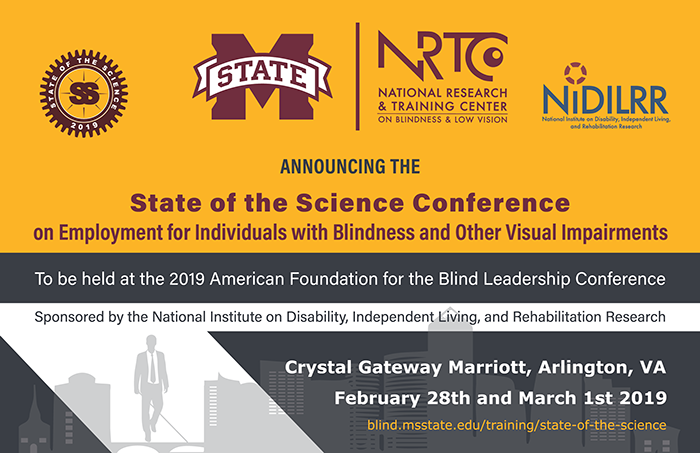The National Research and Training Center on Blindness and Low Vision presented a State of the Science (SOS) Conference on Employment for Individuals with Blindness and Other Visual Impairments at the 2019 American Foundation for the Blind Leadership Conference on February 28 and March 1, 2019. The conference included seven presentations and a poster session focused on research associated with improving employment for individuals with blindness and other visual impairments. A report summarizing the conference, presentation abstracts, with links to research project pages are provided below.
State of the Science Final Report

Conference Session Abstracts
4to24: Development of an App to Help Parents and Youth Focus on Employment
For families of children with visual impairment or dual sensory impairment, information and resources about navigating the path to independence and employment as an adult can be a lifeline. To help fill this need, a new app is being created for parents and youth to help prepare these youth for employment. Tips and resources provided will focus on building skills and independence starting early, and spanning the ages of 4 to 24.
For more information on this research, see the project page:
Project 1: Development of an App to Help Parents and Youth Focus on Employment
Effectiveness of a Job Search Intervention for Youth with Visual Impairments
Working for pay during high school predicts future employment for youth with visual impairments, especially for youth who find their own jobs. Learn about a job search intervention for youth with visual impairments that aims to enhance knowledge, skills, and confidence in independent job-seeking. This session will feature results from a study of the effectiveness of the intervention, and perspectives and experiences of trainers who have implemented the intervention.
For more information on this research, see the project page:
Project 2: Summer Work Experience Plus
An Experiment to Evaluate Approaches to a First Meeting between a VR Professional and an Employer
Can meeting with an employer really help people who are blind or visually impaired become employed? We will present the results of a study that evaluated two different approaches to a meeting with an employer and the impact of vision status on employer attitudes toward, knowledge about, and intent to hire. The two VR professionals who conducted the meetings will share information about the two approaches and their perspectives on the effectiveness of the approaches.
For more information on this research, see the project page:
Project 3: An Experiment to Evaluate Employer Intervention Approaches
Effectiveness of a Business Development Training for Rehabilitation Counselors for the Blind
Working with employers is an important component of the rehabilitation counselors’ job, yet many counselors are not comfortable or prepared for this activity. We will discuss the results of a study that evaluated the effectiveness of a business development training for rehabilitation counselors who work with individuals who are blind or visually impaired. A counselor who participated in the training will discuss his experience and the impact of the training on his business development activities.
For more information on this research, see the project page:
Project 4: The Effectiveness of an Evidence-Based Approach to VR Counselor Training
What We Know About Job Retention and Career Advancement
If you have a significant vision loss, how likely are you to keep working? Learn about the factors and services that influence job retention and career advancement among employed VR applicants and how state agency are addressing these issues. Hear from one VR agency administrator about how their state agency policies support retention and advancement. WIOA has renewed attention to these important topics.
For more information on this research, see the project page:
Project 5: Job Retention and Advancement
Employment for Youth who are Blind or Visually Impaired and Deaf-Blind: Key Predictors and Current Status
We will discuss predictors of post-high school employment for youth who are blind or visually impaired and for youth who are deaf-blind. The most recent information about employment status, from the National Longitudinal Transition Study (NLTS) 2012, will be provided, along with information about factors found to predict post-high school employment for both groups. These factors will be compared over a 10-year period for these two groups, based on NLTS2 and NLTS 2012 data.
For more information on this research, see the project page:
Project 6: Exploration of Secondary Data
New and Emerging Technology to Improve Workplace Accessibility
We will discuss new and emerging technologies that can level the playing field for people who are blind or visually impaired in the workplace. Some technologies are free or low-cost, and mainstream companies are building accessibility into their products more and more. The importance of access to and proper training in the use of available technologies will also be examined. We will discuss how Aira is currently being utilized as a job search and workplace technology.
The State of the Science Conference was supported by a grant from the U.S. Department of Health and Human Services, National Institute on Disability, Independent Living, and Rehabilitation Research (NIDILRR, grant #90RT5040-01-00). NIDILRR is a Center within the Administration for Community Living (ACL), Department of Health and Human Services (HHS). The material from the conference does not necessarily represent the policy of NIDILRR, ACL, or HHS, and you should not assume endorsement by the Federal Government.